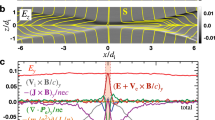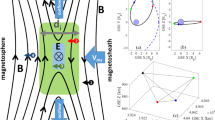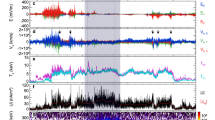Abstract
Magnetic reconnection, the process whereby magnetic field lines break and then reconnect to form a different topology, underlies critical dynamics of magnetically confined plasmas in both nature1,2,3,4 and the laboratory5,6,7,8,9. Magnetic reconnection involves localized diffusion of the magnetic field across plasma, yet observed reconnection rates are typically much higher than can be accounted for using classical electrical resistivity10. It is generally proposed10 that the field diffusion underlying fast reconnection results instead from some combination of non-magnetohydrodynamic processes that become important on the ‘microscopic’ scale of the ion Larmor radius or the ion skin depth. A recent laboratory experiment11 demonstrated a transition from slow to fast magnetic reconnection when a current channel narrowed to a microscopic scale, but did not address how a macroscopic magnetohydrodynamic system accesses the microscale. Recent theoretical models12 and numerical simulations13,14 suggest that a macroscopic, two-dimensional magnetohydrodynamic current sheet might do this through a sequence of repetitive tearing and thinning into two-dimensional magnetized plasma structures having successively finer scales. Here we report observations demonstrating a cascade of instabilities from a distinct, macroscopic-scale magnetohydrodynamic instability to a distinct, microscopic-scale (ion skin depth) instability associated with fast magnetic reconnection. These observations resolve the full three-dimensional dynamics and give insight into the frequently impulsive nature of reconnection in space and laboratory plasmas.
Similar content being viewed by others
Main
The experiment (Fig. 1) involves a long, slender, current-carrying magnetized plasma jet that evolves over the course of ∼50 μs. The jet front travels at ∼10 km s−1, increasing the jet length until the current-driven kink instability, an ideal magnetohydrodynamic (MHD) phenomenon, sets in15 and deforms the plasma jet into a helical structure the amplitude of which grows in time (Fig. 2, Supplementary Fig. 1 and Supplementary Movie 1). The experiments used hydrogen, nitrogen or argon plasma. In all three of these, the kink amplitude growth rate was observed to have one of two distinct behaviours: linear growth or exponential growth (Fig. 2b). Because argon provides the clearest images, argon data will be used in the following detailed discussion.
The experiment produces a magnetized plasma jet using the coplanar disk and annulus electrodes and the background poloidal magnetic field coil shown in cut-away view. The 20-cm-diameter cathode (inner electrode) and the surrounding 50-cm-outer diameter anode (outer electrode) are mounted on the end dome of a 1.4-m-diameter, 1.6-m-long stainless steel vacuum chamber. To make the magnetized plasma jet, first the coil creates a poloidal magnetic field linking the disk to the annulus. Fast pulsed valves then puff in gas at eight locations in front of the anode and eight locations in front of the cathode. A high-energy capacitor bank then applies a potential of 5–6 kV across the electrodes, breaking the gas down into a plasma. The electric current from the capacitor bank ramps up to a peak amplitude of ∼110 kA, with a full-width at half-maximum of ∼60 μs. The electric current flows along the jet column, producing a ∼0.1-T toroidal (φ direction) magnetic field, and completes its path along an outer, low-density, low-poloidal-magnetic-field shroud surrounding the jet. The jet is propelled in the z direction by the combination of the axial gradient of the toroidal magnetic field and the axial gradient of the hydrodynamic pressure resulting from the radial pinch force due to the current22. Diagnostic devices include a visible-light fast framing camera with a 20-ns shutter and an adjustable ∼1-μs interframe time, a gated, 12-channel linear spectroscopic array23 (lines of sight indicated in red) with a 2-cm line-of-sight separation and a 1-μs time resolution, a capacitively coupled probe and extreme-ultraviolet (EUV) diodes sensitive within the 10–75-eV energy range.
a, Example of measurement of the kink amplitude, ξ, in a fast framing camera image of shot no. 10,934. The plasma jet undergoes a kink instability in agreement with the prediction of Kruskal–Shafranov theory15,24: the jet is unstable to kinking when μ0I/Ψ > 4π/L, where L is the jet length, I is the current measured at the electrodes and Ψ is the poloidal magnetic flux measured at the electrodes. Image intensity is logarithmically scaled and false coloured. b, Comparison of exponential kink growth rate and linear kink growth rate as measured from fast camera images. Black points indicate kink amplitude with exponential growth, ξ ∝ exp(γkinkt), where γkink = 8.3 × 105 s−1 (shot no. 10,934). Brown points indicate kink amplitude with linear growth, ξ ∝ t (shot no. 10,930). Lines show best fits to the data. Error bars indicate the range of possible plasma edge positions based on image intensity.
In the case of an exponentially growing kink, the jet segment develops a periodic fine structure (Fig. 3). The fine-structure growth rate, location and spatial periodicity are consistent with the magnetized plasma Rayleigh–Taylor instability16. This instability develops in a gravitational field at an interface where a heavy fluid with density ρ2 lies above a light fluid with density ρ1. The acceleration of the exponentially growing kink segment creates an effective gravitational field, geff, in the plasma frame. To an observer in the frame of the accelerating filamentary kink segment at the location of the periodic structure (on the inward side of the outward accelerating filament, that is, the trailing side), the plasma filament appears to be a heavy fluid sitting on top of trailing low-density fluid immediately exterior to the filament.
For exponential kink amplitude growth, shown here, a segment of the kinked jet quickly narrows to a thin filament, which then brightens while developing a sharp, distinctive, periodic fine structure on the trailing side of the radially outward-accelerating filament. As the fine-structure amplitude grows, it erodes the filament diameter until the filament breaks up. The dashed line in the first image shows the position of the inner electrode. The measured transverse acceleration of the filament when the periodic fine structure first appears is geff ≈ 4 × 1010 m s−2. The axial wavelength, as measured from the fast camera images, is λz ≈ 2 cm, which implies that k ≈ 300 m−1. These measurements give a calculated Rayleigh–Taylor growth rate of γRT ≈ 3 × 106 s−1. For comparison, the growth rate can be estimated directly from the fast camera images. The fine-structure amplitude is ∼0.5 cm when it first appears and grows to ∼1.5 cm in 1 μs. This corresponds to an observed growth rate of γRT ≈ 1 × 106 s−1, in agreement with the calculated growth rate. All images are from shot no. 11,225; image intensity is logarithmically scaled and false coloured. See also Supplementary Movie 2.
The fastest-growing mode of the magnetized plasma Rayleigh–Taylor instability has k̇B = 0 (where k is the instability wavevector and B is the magnetic field vector), a property that will be useful in the interpretation of the experiment. If we assume that the plasma density inside the filament greatly exceeds the density immediately outside, that is, ρ2  ρ1, then the exponential growth rate for the fastest-growing Rayleigh–Taylor mode is16
ρ1, then the exponential growth rate for the fastest-growing Rayleigh–Taylor mode is16  , where k = 2π/λ and λ is the wavelength of the fine structure. For the plasma shown in Fig. 3, the calculated growth rate is γRT ≈ 3 × 106 m s−1 and the visually observed growth rate is γRT ≈ 106 m s−1. The agreement between these two rates and the observation that the instability is located on the trailing side of the transversely accelerated filament together support the conclusion that the fine-scale instability is a Rayleigh–Taylor instability.
, where k = 2π/λ and λ is the wavelength of the fine structure. For the plasma shown in Fig. 3, the calculated growth rate is γRT ≈ 3 × 106 m s−1 and the visually observed growth rate is γRT ≈ 106 m s−1. The agreement between these two rates and the observation that the instability is located on the trailing side of the transversely accelerated filament together support the conclusion that the fine-scale instability is a Rayleigh–Taylor instability.
When the thin filament breaks up as a result of the Rayleigh–Taylor instability, the portion of the jet beyond the break-up region retains its magnetic structure and separates from the remaining jet base (Fig. 3 and Supplementary Fig. 2), demonstrating a clear magnetic reconnection. Several additional diagnostics support the conclusion that magnetic reconnection is occurring. Photodiodes sensitive within the 10–75-eV energy range measure a burst of extreme ultraviolet radiation coincident with the filament break-up (Supplementary Fig. 3). A capacitively coupled probe placed in the plasma jet between the electrodes and the filament measures an order of magnitude increase in emissions in the whistler-wave frequency range coincident with the filament break-up17 (Supplementary Fig. 4).
We can verify that the reconnecting plasma is indeed at the non-MHD microscale by recalling that ideal MHD is based on the presumption that vd/vA  1. Here vd = Jz/nq is the electron drift velocity for an axial current density Jz, where n is particle density and q is electron charge; and
1. Here vd = Jz/nq is the electron drift velocity for an axial current density Jz, where n is particle density and q is electron charge; and  is the Alfvén velocity, where B is the magnetic field strength, mi is the ion mass and μ0 is the permeability of free space. When vd/vA becomes of order one, the assumptions underlying ideal MHD fail because kinetic effects (that is, wave–particle interaction) and Hall term effects (that is, decoupling of electron and ion perpendicular motions) become important. If we assume that B ≈ Bz and use k̇B = 0 (which holds for the fastest-growing Rayleigh–Taylor mode), we see that
is the Alfvén velocity, where B is the magnetic field strength, mi is the ion mass and μ0 is the permeability of free space. When vd/vA becomes of order one, the assumptions underlying ideal MHD fail because kinetic effects (that is, wave–particle interaction) and Hall term effects (that is, decoupling of electron and ion perpendicular motions) become important. If we assume that B ≈ Bz and use k̇B = 0 (which holds for the fastest-growing Rayleigh–Taylor mode), we see that

where λz is the local axial wavelength. This means that  , where c is the speed of light and ωpi is the ion plasma frequency (c/ωpi is the ion skin depth).
, where c is the speed of light and ωpi is the ion plasma frequency (c/ωpi is the ion skin depth).
Using c/ωpi calculated with n ≈ 1022 m−3 as determined from Stark-broadening density measurements and the measured fine-structure local axial wavelength, λz = 2 cm, we find that vd/vA ≈ O(1). This shows that the filament observed to have a Rayleigh–Taylor instability is in the non-MHD regime at the time of magnetic reconnection.
Because the original kink instability was in the ideal-MHD regime, our argon plasma observations thus show a cascade from an ideal-MHD macroscopic kink instability to a non-ideal, microscopic Rayleigh–Taylor instability associated with magnetic reconnection. A question that remains to be answered is what determines whether the kink instability grows linearly or exponentially.
By contrast with its behaviour in argon, the Rayleigh–Taylor instability in hydrogen fails to break the plasma filament. Although we still observe an exponentially growing kink and subsequent Rayleigh–Taylor instability in hydrogen, the ion skin depth, c/ωpi, is substantially smaller than in argon and the Rayleigh–Taylor instability fails to erode the plasma filament to a diameter less than this smaller depth (Supplementary Fig. 5), though we are not yet certain why. Thus, the hydrogen plasma diameter has not been reduced to the necessary microscale and no magnetic reconnection takes place.
Reconnection is observed in the nominal parameter regime of these experiments only when preceded by the Rayleigh–Taylor instability; this implies that the Rayleigh–Taylor instability is necessary for the observed reconnection to occur. However, the comparison between argon and hydrogen plasmas shows that the mere existence of the Rayleigh–Taylor instability is not sufficient for reconnection: the Rayleigh-Taylor instability must become large enough to erode the filament diameter to less than the ion skin depth for magnetic reconnection to occur.
Our observations demonstrate one possible mechanism by which a macroscopic MHD system can couple to the microscale processes necessary for magnetic reconnection. The essential components of this mechanism have been separately observed in nature. For example, in the solar corona current-carrying magnetic flux tubes confining plasma with density higher than the ambient value are common, as is kinking of such flux tubes18,19, and Rayleigh–Taylor instabilities have been observed20.
Given that we observe this mechanism in a range of laboratory experiments, we think it quite plausible that it will also occur in astrophysical systems with appropriate physical parameters. As a possible example, we note that one solar observation21 reported the lateral acceleration of a plasma-filled flux tube at ∼1 km s−2. Assuming that such acceleration is typical, for a 104-km-wide solar loop a Rayleigh–Taylor disturbance with an axial wavelength of 400 km and an initial amplitude of 0.5 km would grow exponentially to the 104-km loop width in about 1 min and so erode the current channel to a microscopic scale. Because the instability wavelength assumed in this example is at the margin of existing resolution capabilities, measurements that simultaneously resolve the widely separated macro- and microscales would be challenging.
References
Paschmann, G. et al. Plasma acceleration at the Earth’s magnetopause: evidence for reconnection. Nature 282, 243–246 (1979)
Mikic, Z., Barnes, D. C. & Schnack, D. D. Dynamical evolution of a solar coronal magnetic field arcade. Astrophys. J. 328, 830–847 (1988)
Colgate, S., Li, H. & Pariev, V. The origin of the magnetic fields of the universe: the plasma astrophysics of the free energy of the universe. Phys. Plasmas 8, 2425–2431 (2001)
Uzdensky, D. A. & MacFadyen, A. I. Stellar explosions by magnetic towers. Astrophys. J. 647, 1192–1212 (2006)
Wesson, J. A. Sawtooth reconnection. Nucl. Fusion 30, 2545–2549 (1990)
Yamada, M. et al. Investigation of magnetic reconnection in a high-temperature tokamak plasma. Phys. Plasmas 1, 3269–3276 (1994)
Bellan, P. M. Spheromaks 60–75 (Imperial Coll. Press, 2000)
Taylor, J. B. Relaxation and magnetic reconnection. Rev. Mod. Phys. 58, 741–763 (1986)
Brown, M. Experimental studies of magnetic reconnection. Phys. Plasmas 6, 1717–1724 (1999)
Yamada, M., Kulsrud, R. & Ji, H. Magnetic reconnection. Rev. Mod. Phys. 82, 603–664 (2010)
Egedal, J. et al. Laboratory observations of spontaneous magnetic reconnection. Phys. Rev. Lett. 98, 015003 (2007)
Shibata, K. & Tanuma, S. Plasmoid-induced-reconnection and fractal reconnection. Earth Planets Space 53, 473–482 (2001)
Che, H., Drake, J. F. & Swisdak, M. A current filamentation mechanism for breaking magnetic field lines during reconnection. Nature 474, 184–187 (2011)
Drake, J. F. et al. Formation of secondary islands during magnetic reconnection. Geophys. Res. Lett. 303, L13105 (2006)
Hsu, S. C. & Bellan, P. M. Experimental identification of the kink instability as a poloidal flux amplification mechanism for coaxial gun spheromak formation. Phys. Rev. Lett. 90, 215002 (2003)
Chandrasekhar, S. Hydrodynamic and Hydromagnetic Stability 464–466 (Dover, 1961)
Gekelman, W. & Stenzel, R. L. Magnetic field line reconnection experiments: 6. Magnetic turbulence. J. Geophys. Res. 89, 2715–2733 (1984)
Srivastava, A. K., Zaqarashvili, T. V., Kumar, P. & Khoachenko, M. L. Observation of kink instability during small B5.0 solar flare on 2007 June 4. Astrophys. J. 715, 292–299 (2010)
Zhou, G. P. et al. Two successive coronal mass ejections driven by the kink and drainage instabilities of an eruptive prominence. Astrophys. J. 651, 1238–1244 (2006)
Berger, T. et al. Magneto-thermal convection in solar prominences. Nature 472, 197–200 (2011)
Liu, C. et al. The eruption from a sigmoidal solar active region on 2005 May 13. Astrophys. J. 669, 1372–1381 (2007)
Kumar, D. & Bellan, P. M. Nonequilibrium Alfvénic plasma jets associated with spheromak formation. Phys. Rev. Lett. 103, 105003 (2009)
Yun, G. S. & Bellan, P. M. Plasma tubes becoming collimated as a result of magnetohydrodynamic pumping. Phys. Plasmas 17, 062108 (2010)
Hsu, S. C. & Bellan, P. M. A laboratory plasma experiment for studying magnetic dynamics of accretion discs and jets. Mon. Not. R. Astron. Soc. 334, 257–261 (2002)
Acknowledgements
This work supported by the US DOE, NSF and AFOSR.
Author information
Authors and Affiliations
Contributions
A.L.M. performed the experiments and analysed data. A.L.M. and P.M.B. discussed and interpreted the results and wrote the manuscript.
Corresponding author
Ethics declarations
Competing interests
The authors declare no competing financial interests.
Supplementary information
Supplementary Figures
This file contains Supplementary Figures 1-5 with legends. They are fast camera images that show helical plasma geometry and plasma filament breaking; EUV diode data and capacitively coupled probe data highlight the difference in reconnecting and non reconnecting plasmas; fast camera image shows hydrogen does not reach miscrocale. (PDF 3175 kb)
Supplementary Movie 1
This movie shows an overview of the experiment: the plasma jet grows and then undergoes first a kink instability and then a Rayleigh-Taylor instability before reconnecting. (MOV 1143 kb)
Supplementary Movie 2
This movie version of Figure 3 shows the kink instability and Rayleigh-Taylor instability in greater detail. (MOV 577 kb)
Rights and permissions
About this article
Cite this article
Moser, A., Bellan, P. Magnetic reconnection from a multiscale instability cascade. Nature 482, 379–381 (2012). https://doi.org/10.1038/nature10827
Received:
Accepted:
Published:
Issue Date:
DOI: https://doi.org/10.1038/nature10827
This article is cited by
-
Generation of laboratory nanoflares from multiple braided plasma loops
Nature Astronomy (2023)
-
Current Sheets, Plasmoids and Flux Ropes in the Heliosphere
Space Science Reviews (2021)
-
Dynamic formation of stable current-driven plasma jets
Scientific Reports (2019)
-
The magnetic Rayleigh–Taylor instability in solar prominences
Reviews of Modern Plasma Physics (2018)
-
Achieving a long-lived high-beta plasma state by energetic beam injection
Nature Communications (2015)
Comments
By submitting a comment you agree to abide by our Terms and Community Guidelines. If you find something abusive or that does not comply with our terms or guidelines please flag it as inappropriate.






